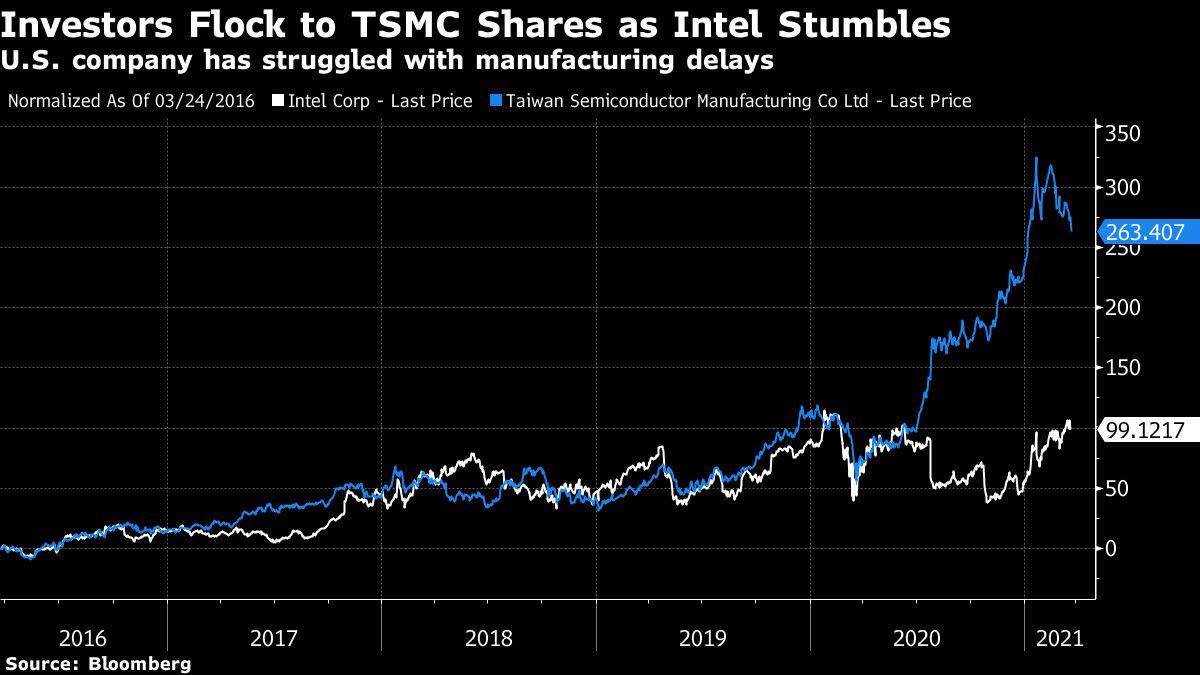
(Bloomberg) -- Intel Corp. unveiled a grand plan Tuesday to restore its past chipmaking glory. To succeed, new Chief Executive Officer Pat Gelsinger must embrace a strategy the old Intel never dreamed of: playing nice with rivals.
“Intel is back. The old Intel is the new Intel,” he said. “We’re going to be leaders in the market and we’re going to satisfy the new foundry customers, because the world needs more semiconductors and we’re going to step into that gap in a powerful and meaningful way.”
Intel shares jumped 7% on the plan. Yet key parts of the strategy are new territory for a company that’s used to doing everything its own way. Intel has almost always designed and produced its semiconductors in-house. Now, Gelsinger is starting a foundry business that will manufacture chips for other companies. And he also plans to use rivals’ factories to outsource production of more Intel components.
This will create complex new relationships. For instance, Taiwan Semiconductor Manufacturing Co. runs the world’s leading chip foundry business. Intel is now encroaching on TSMC’s turf, while also expecting this rival to make some of Intel’s best chips.
“TSMC will do as much for Intel as they feel they have to,” said Matt Ramsay, an analyst at Cowen & Co.
Read more: Intel’s $20 Billion Foundry Plan Hits Shares of TSMC, Samsung
Before other chip companies commit to using Intel’s factories, it has to fix its own manufacturing problems, the analyst added. Intel’s latest 7-nanometer production process has been delayed and that followed several missed deadlines for the previous 10-nanometer standard. Gelsinger said on Tuesday these issues have been fixed, but analysts are dubious.
“We simply don’t understand why customers would strongly support an Intel foundry given that Intel is so far behind on process technology, and doesn’t yet possess the standard libraries needed to compete with TSMC,” said Chris Caso, an analyst at Raymond James.
Charles Shum, an analyst at Bloomberg Intelligence, said big technology companies, such as Apple Inc. and Qualcomm Inc., will hesitate to shift orders to Intel because they compete with the company in designing chips.
TSMC Can Fight Off Intel Challenge in Chip Manufacturing: React
Gelsinger began his career at Intel in the 1970s and worked his way up the ranks to run some of its biggest units. He left in 2009 when Intel was approaching its zenith using a strategy he helped put in place. Intel introduced new products and new manufacturing technology at a blistering cadence that competitors couldn’t match, and PC and server customers built their product cycles around it.While he mentioned a return to that “tick-tock” discipline on Tuesday, Gelsinger will have to lean on the recent experience he gained as head of software maker VMware Inc. to navigate a more complex world for Intel.
During a presentation with analysts on Tuesday, Gelsinger said the way semiconductors are designed and manufactured has changed. Parts of chips can now be made in different places using different technologies, then combined in packages. This helps designers pick and choose what fits their needs best -- and it makes the old Intel model of keeping it all under one roof less relevant.
Intel showed off the logos of Qualcomm and other companies that it said are supporting its foundry push. With rising geopolitical and trade tensions between China and the U.S., customers want suppliers with facilities outside of Taiwan, Intel said.
Read more: The World Is Dangerously Dependent on Taiwan for Semiconductors
Gelsinger is shaking it up further by doing something his predecessors would have deemed sacrilege. Intel used to jealously guard its X86 processor technology, the dominant instruction set for computer microprocessors. Now this will be available as a design if Intel foundry customers want to use it. And they can combine that with rival approaches such as those offered by Arm Ltd. and an open-source standard called RISC-V, he said.Intel has tried and failed as a foundry before. This effort is different because customers will get access to Intel’s best manufacturing techology, Gelsinger said. And there are at least two new factories being built for the effort.“Our past attempts were somewhat half-hearted,” Gelsinger said. “Customers will get the best we’ve got to offer.”
New Intel CEO May Drive Improved EPS, Valuation: Company OutlookTo make his goals clear internally, Gelsinger has set up a separate division called Intel Foundry Services that will report its own financial performance and therefore have to align itself with customers’ interests to guarantee it meets targets.“If he’s really dedicated to the benefits he’s touting today, then this will put Intel on a much more competitive footing,” Loop Capital Markets analyst Cody Acree said in an interview with Bloomberg Television. “You are going to get this honeymoon period that Mr. Gelsinger is in today where people are looking for the changes, looking for optimism, anything to hang onto with Intel. That’s the right thing to do. But it’s also pretty shortlived.”
For more articles like this, please visit us at bloomberg.com
Subscribe now to stay ahead with the most trusted business news source.
©2021 Bloomberg L.P.
Business - Latest - Google News
March 24, 2021 at 11:17AM
https://ift.tt/3cUaLze
Intel CEO Charts Comeback on Foundry Model TSMC Mastered - Yahoo Finance
Business - Latest - Google News
https://ift.tt/2Rx7A4Y
Bagikan Berita Ini














0 Response to "Intel CEO Charts Comeback on Foundry Model TSMC Mastered - Yahoo Finance"
Post a Comment